剑桥雅思9:Test4雅思阅读PASSAGE3真题+答案+解析
发布时间:2021-06-30 关键词: 剑桥雅思9:Test4雅思阅读Reading
The Development of
Museums
A The convicton that historical relics provide ifallible testimony about the past isrooted in the nineteenth and early twentieth centuries, when science was regardedas objective and value free. As one writer observes: 'Although it is now evident thatartefacts are as easily altered as chronicles, public faith in their veracity endures: atangible relic seems ipso facto real. Such conviction was, until recently, reflected inmuseum displays. Museums used to look - and some still do - much like storagerooms of objects packed together in showcases: good for scholars who wanted tostudy the subtle differences in design, but not for the ordinary visitor, to whom it alllooked alike. Similarly, the information accompanying the objects often made littlesense to the lay visitor, The content and format of explanations dated back to a timewhen the museum was the exclusive domain of the scientific researcher.
B Recently, however, attitsdes towards history and the way it should be presentedhave altered. The key word in heritage display is now 'experience, the more excitingthe better and, if possible, involving all the senses. Good examples of this approachin the UK are the Jorvik Centre in York; the National Museum of Photography, Flm
and Television in Bradford; and the Imperial War Museum in London. In the US
the trend emerged much earlier: Wiliamsburg has been a prototype for many
heritage developments in other parts of the world. No one can predict where theprocess will end. On so-called heritage sites the re-enactment of historical eventsis increasingly popular, and computers will soon provide virtual reality experiences,which will present visitors with a vivid image of the period of their choice, in whichthey themselves can act as if part of the historical environment, Such developmentshave been criticised as an intolerable vulgarisation, but the success of many historicaltheme parks and similar locations suggests that the majority of the public does notshare this opinion.
C In a related development, the sharp distinction between museum and heritage siteson the one hand, and theme parks on the other, is gradually evaporating. They alreadyborrow ideas and concepts from one another. For example, museums have adoptedstory lines for exhibitions, sites have accepted 'theming' as a relevant tool, and themeparks are moving towards more authenticity and research-based presentations. Inz0os, animals are no longer kept in cages, but in great spaces, either in the open air orin enormous greenhouses, such as the jungle and desert environments in Burgers 'Zooin Holland. This particular trend is regarded as one of the major developments in thepresentation of natural history in the twentieth century.
D Theme parks are undergoing other changes, too, as they try to present more serioussocial and cultural issues, and move away from fantasy. This development is a
response to market forces and, although museums and heritage sites have a special,rather distinct, role ta fulfl, they are also operating in a very competitive environment,where visitors make choices on how and where to spend their free time. Heritage andmuseum experts do not have to invent stories and recreate historical environmentsto attrat their visitors: their assets are already in place. However, exhibits must beboth based on artefacts and facts as we know them, and attractively presented. Thosewho are professionally engaged in the art of interpreting history are thus in a difcultposition, as they must steer a narrow course between the demands of 'evidence'and' atratiess, especially given the increasing need in the heritage industry forincome-generating activities,
E It could be dlaimed that in order to make everything in heritage more 'real', historicalaccuracy must be increasingly altered. For example, Pithecanthropus erectus
is depicted in an Indonesian museum with Malay facial features, because this
corresponds to public perceptions. Similarly, in the Museum of Natural HistoryinWashington, Neanderthal man is shown making a dominant gesture to his wife, Suchpresentations tell us more about contemporary perceptions of the world than aboutour ancestors. There is one compensation, however, for the professionals who makethese interpretations: if they did not provide the interpretation, visitors would doitfor themselves, based on their own ideas, misconceptions and prejudices. And nomatter how exciting the result, it would contain a lot more bias than the presentationsprovided by experts.
F Human bias is inevitable, but another source of bias in the representation of historyhas to do with the transitory nature of the materials themselves. The simple factisthat not everything from history survives the historical process. Castles, palaces andcathedrals have a longer lfespan than the dwellings of ordinary people. The sameapplies to the furnishings and other contents of the premises. In a town like Leyden inHolland, which in the seventeenth century was occupied by approximately the samenumber of inhabitants as today, people lived within the walled town, an area morethan five times smaller than modern Leyden. In most of the houses several familieslived together in circumstances beyond our imagination. Yet in museums, fine periodrooms give only an image of the lifestyle of the upper class of that era. No wonderthat people who stroll around exhibitions are flld with nostalgia; the evidence inmuseums indicates that life was so much better in the past. This notion is induced bythe bias in its representation in museums and heritage centres,
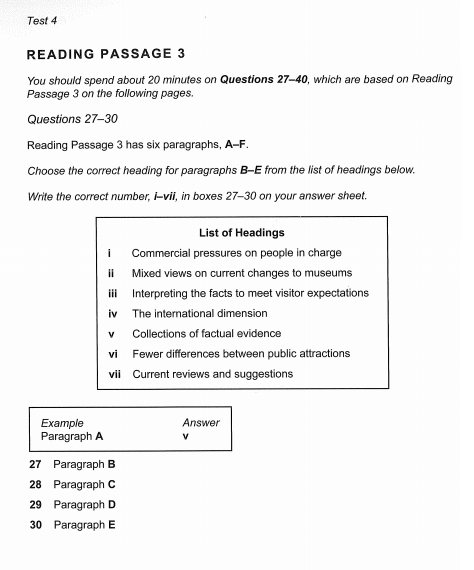
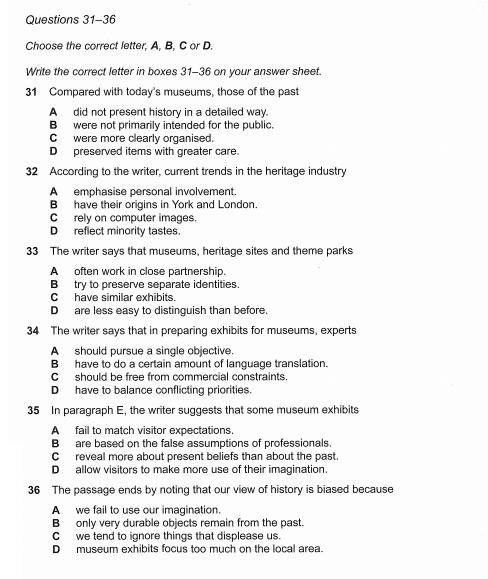
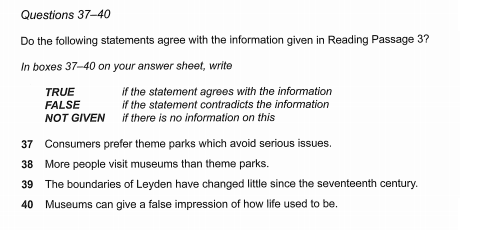
剑桥雅思9Test4阅读Passage3答案
Question 27—30:ii、vi、i、iii
Question 31—36:B、A、D、D、C、B
Question 24—26:F、NG、F、T
剑桥雅思9Test4阅读Passage3答案:
体 裁 议论文
题 材 历史展馆的发展
主 题 博物馆的发展
段落概括
A段 引出话题:博物馆文物的信息介绍的真实性
B段 对历史的态度和它所呈现的方式所发生的变化
C段 博物馆、文物遗址和主题公园的差异性逐渐消失。
D段 主题公园的其他变化
E段 文物的历史精确性发生变化。
F段 人类对历史产生了偏见。
雅思阅读重点词汇
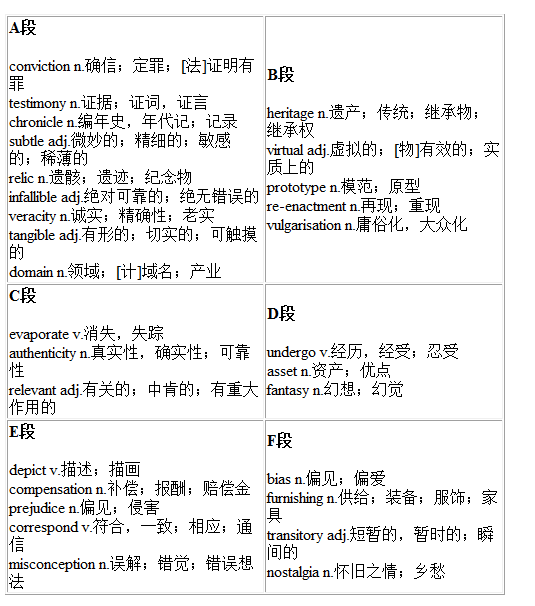
考题精解
Questions 27-30
题型:标题题LIST OF HEADINGS
解析:本题型的考查点是段落的主旨,所以必须把握段落的主题句,通常是每段句、第二句或最后一句。根据主题句的意思在选项中找到同义替换所对应的选项。解答此类题型时,考生通常出现的误区是抓住段落中一些描述细节信息的词汇在选项中直接找对应。
27.
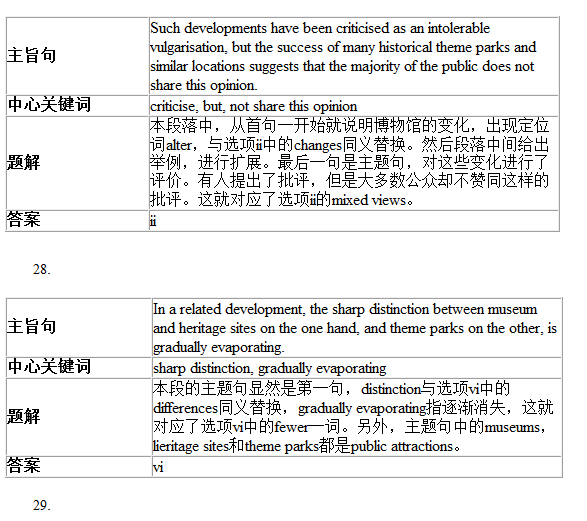

Questions 31-36
题型:单选题 MULTIPLE CHOICE
解析:本题型为单项选择题,一般是对原文细节信息的考查。做题遵循顺序原则,但是这种题型的难点在于考查点是同义替换。考生可利用题干中的定位词找出题目在文章中的具体位置然后依据涉题句的含义选出正确答案。
31.
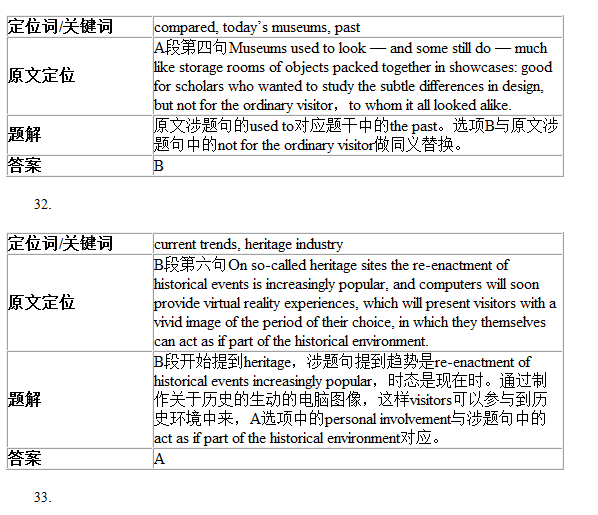
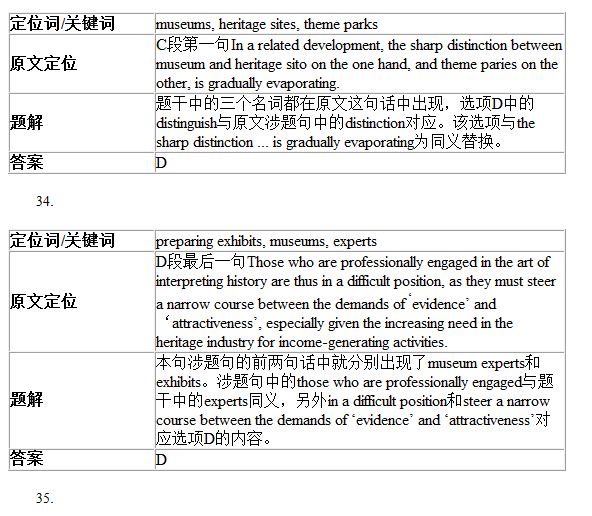
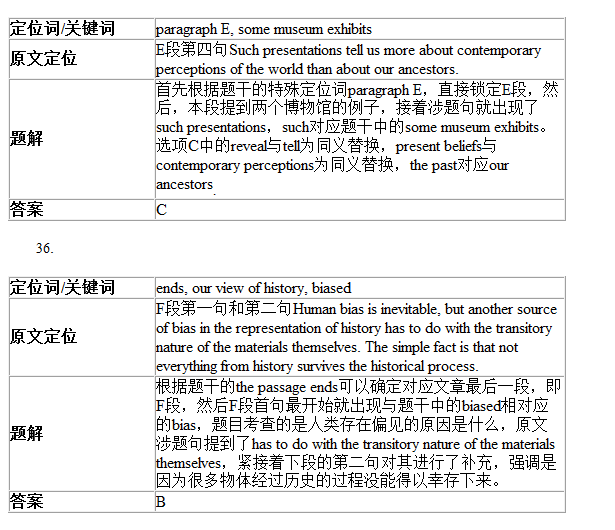
Questions 37-40
题型:判断题 TRUE/FALSE/NOT GIVEN
解析:判断题一般都是按照正序出题,确定了个题目在原文中的定位,便可根据顺序原则依次寻找其他题目的答案。做判断题时注意划好定位词,定位词可以帮助考生迅速找到题目在原文中出现的位置,以便进一步判断题干信息的正误。
37.
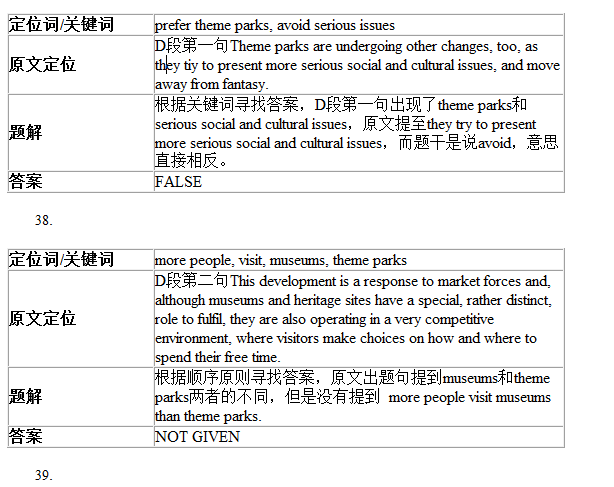
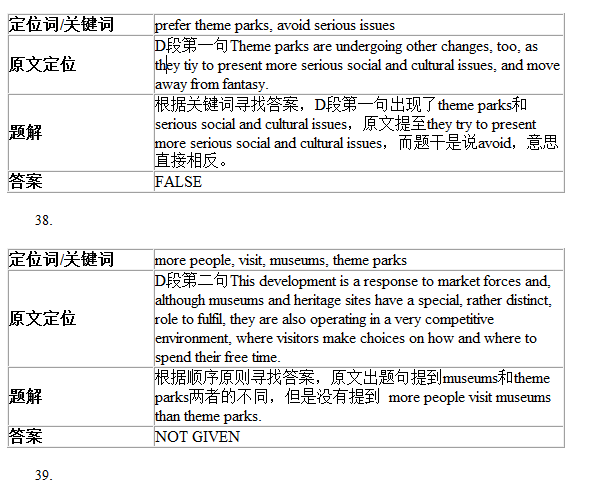
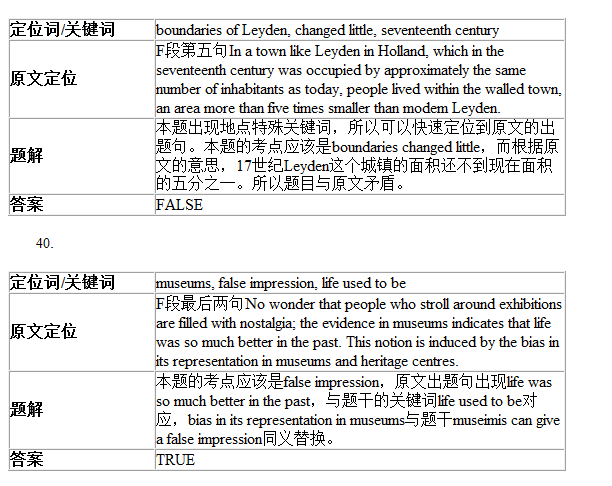
剑9阅读难句解析
1.Museums used to look — and some still do — much like storage rooms of objects packed together in showcases: good for scholars who wanted to study the subtle differences in design, but not for the ordinary visitor, to whom it all looked alike.
解析:and some still do是插入成分,good for scholars ... but not for the ordinary visitor是转折关系,它们的后面又分别出现了who引导的定语从句。
参考翻译:博物馆过去看起来——而且现在有一些仍然看起来,非常像摆放了挤满东西的陈列柜的储藏室,它们对那些想研究设计的细微差别的学者来说很有帮助,但对普通游客来说没有什么用处,在他们看来,这些看起来都一样。
2.Those who are professionally engaged in the art of interpreting history are thus in a difficult position, as they must steer a narrow course between the demands of ‘evidence’ and ‘attractiveness’, especially given the increasing need in the heritage industry for income-generating activities.
解析:这句话的主干是those are thus in a difficult position,其中,关系代词who引导的是定语从句,as引导的是原因状语从句。
参考翻译:那些专业从事诠释历史艺术工作的人陷入了困境,因为他们必须在“证据”和“吸引力”的两个要求之间平衡,尤其是考虑到遗产对创收活动不断增长的需求。
以上便是新航道雅思为各位雅思考生带来剑桥雅思9真题+解析-Test4阅读Passage3,p1请:剑桥雅思9Test4阅读Passage1答案+解析,p2请:剑桥雅思9Test4阅读Passage2答案解析。




